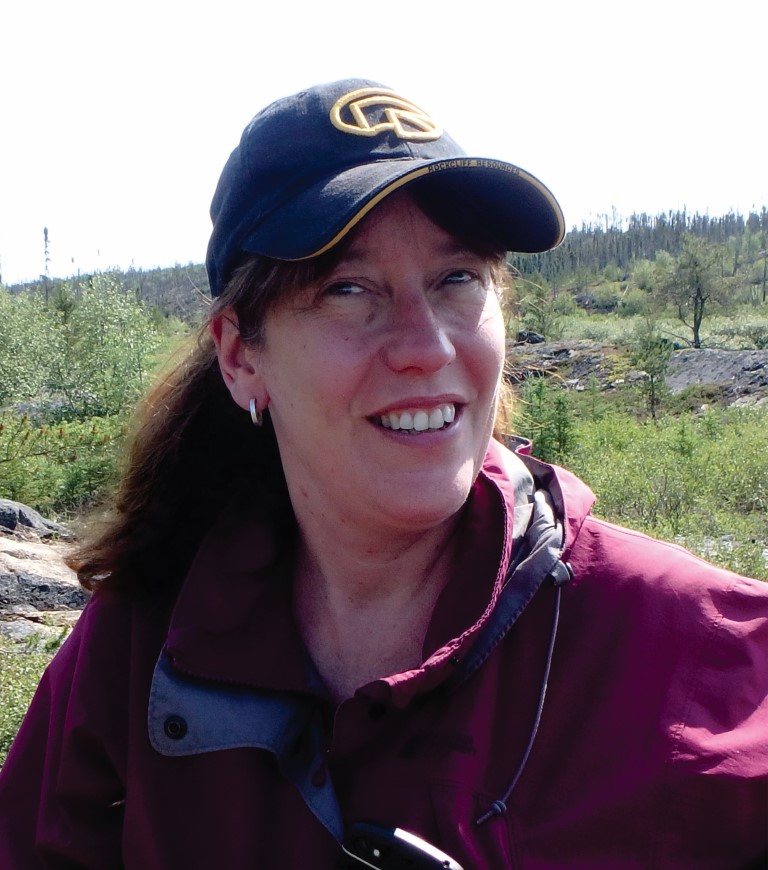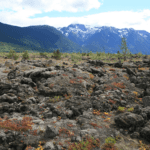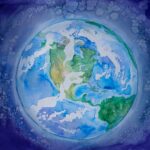 Canadian Science Publishing welcomes Dr. Sally Pehrsson, the new Co-Editor-in-Chief of the Canadian Journal of Earth Sciences.
Canadian Science Publishing welcomes Dr. Sally Pehrsson, the new Co-Editor-in-Chief of the Canadian Journal of Earth Sciences.
Dr. Pehrsson is a project leader and research scientist at the Geological Survey of Canada. Dr. Pehrsson’s work focuses on Precambrian tectonics and she has led projects targeted on geoscience for energy and mineral programs.
Listen to our interview with Dr. Pehrsson or read the interview below:
Some of the questions and answers have been edited for brevity and clarity.
Dr. Pehrsson, thank you so much for giving us this time and, of course, for your contributions to the Canadian Journal of Earth Sciences. I wonder if you could talk about your own research interests and maybe a bit about your work at the Geological Survey of Canada (GSC). I noted that you started at the GSC in the early 1990s, a while before you completed your doctorate. Was your initial role more in applied areas and less on fundamental studies?
I was initially hired out of my master’s degree to be a junior researcher assisting a more senior research team. And after a couple of years, they gave me this incredible opportunity to go back and do my doctorate. It was nerve racking and exciting at the same time. I was a young graduate student—first-year PhD student—that was thrown into field research in Arctic Canada, leading a crew of six scientists in a very remote, fly-in fly-out camp, at the same time as conducting my own research.
So, as you can imagine, it was a lot at once. Bears, planes, rocks, you name it. It was an incredible challenge, and it was just a phenomenal opportunity that the Geological Survey gave me. After that I became a full research scientist. Since then, I guess I have worked in every origin and part of the Canadian Shield. I have also worked in the Appalachians and I’ve worked in what we call the Grenville, which is the one-billion-year old mountain range that stretches through Ontario and Quebec. You would know it as the Laurentian Mountains. The only part I haven’t worked in is the Canadian Cordillera.
You are a Precambrian geologist by training and a structural geologist. But your CV speaks of other interests beyond this arena and internationally. Is there a particular project or work that occupies you most in this broader regard?
Over the years, I’ve gotten very involved in an international effort to develop plate reconstruction. So, if you have heard of Pangea and of other times we have had single super continents in the past, it has happened multiple times through earth’s history. The Canadian Shield was an integral part of it at different junctures, and so I have been trying to complete the puzzle of what parts were the Canadian Shield connected to at different times. I became very involved in developing reconstruction. So, colleagues and I have had several models that we published. But we’ve also started to look at the implications for the feedback between tectonics and atmosphere and the oceans, and how it may have linked to the early rise of oxygen in earth and some of the first more complex creatures. Yeah, it’s very rewarding.
I assume that it’s rewarding from many different perspectives for many different reasons for different people. What would be your specific interests in this realm?
As a structural geologist, I come at it from the perspective of mountain building processes, but I have always been interested also, as a federal government scientist, in it for the implications for ore deposit studies. We try to marry understanding the puzzle of where Canada’s Shield has been with what other parts of world have in terms of its metal endowment and how that might be related. So, it’s a very large, three-dimensional, deep-time puzzle that we’re trying to sort out.
When you say simulation, is that largely computer modelling or is it more in the framework for a model?
It is computer modelling because we’re representing what we know the plates look like today from our work in all sorts of different facets from satellite to boots-on-the-ground mapping. But we can take that knowledge base and basically snap it into a model of the plates. Then that information rides with it like, you know, ducks on mother’s back. And so you can actually take the plates, break them into pieces that we think they were originally in and move them around and rearrange them. And it’s all done in a computer system, in a really phenomenal program called GPlates, which many scientists in my field use around the world where you can actually animate where things move based on different set of criteria. And so, we’re able to make complete, full-scale animated models of how the plates came together and subsequently broke apart. Similar to what’s been done for a number of years for Pangea. But it’s getting more and more sophisticated, and we’re able to put more and more information and data with it.
Could you give us some examples of the kind of data?
Things like the magnetic striping of the sea floor can be attached to the plates that you’re moving around or the gravity or other big-scale regional datasets. But the thing that the science is moving towards is being able to take smaller scale point datasets and make them ride with these plates and move. So, you can test different models. You can say, you know, does this line of magmatic intrusions follow from one plate to another and therefore we think that they were originally connected and subsequently were broken apart. Similar to what you do when you look at Pangea, and they recognize there was a fit between Africa and South America and that there was a fit between the paleontology of the different sequences along those margins. We use the same features whether its ranges of metamorphism and mountain building, sedimentary basins, ages of crust formation, dikes forms—all of that can be put in and used to do this matching history.
And so, what have we learned from this?
So, for example, we know that what we call the Taconian or part of the early Appalachian Mountain building event goes all the way through Newfoundland and that it is actually found, vestiges of it, in central northern Norway, Northern Ireland, and parts Scotland—so they may be dispersed now but we can we can actually match them up with those types of data sets.
I was thinking when you were talking about the Appalachian type of structures extending beyond into Newfoundland and up into Scotland, whether we can guess that there are similar sort of deposits or is it the dynamics of the tectonics?
Both actually, one of the things about the deposits that’s quite interesting is that a number of them occur in very specific tectonic settings. So, if you have made a plate reconstruction that has a blacks, what’s called the volcanic-hosted massive sulfide deposit, these form in the black smokers that are that are on the seafloor. Those deposits only get preserved when they are obducted back onto land because they form in a deep marine setting. If you’ve got a reconstruction that places a well age-constrained, volcanic-hosted massive sulfide deposit right smack in the middle of your plate, but with no preceding collision, you’ve got a problem.
So, they can actually be partly predictive. But at the same time, some of the settings in which they can occur are over long distances because you get chains of deposits, because you have a very similar sedimentary or sedimentary magmatic tectonic system.
So, for example, by Bayan Obo—the world’s largest single rare earth deposit, where much of the metals for our cell phones, etcetera come from—formed in an ancient rift system some where between about 1.6 and 1.3 billion years ago. And with the nature of that very specific system, we’ve actually started to work into trying to place North China where it was at around that time and see if the long stripe continuation of those same rift sequences hosts similar mineralisation, which it can do. Not always, but often does. So, there are certain types of metal deposits that make this game of jigsaw puzzle very, very important to look at.
So, if I understand you correctly, not all mineral deposits adhere to this phenomenon. But could you give some examples of a few that do?
Large copper-gold deposits occur in very long magmatic chains that can be broken up and be in specific places later. Other types don’t. But the fascinating thing for me is how there is a feedback between this because we’ve been able to use certain features such as the uranium district in Northern Saskatchewan, it is the world’s largest producing unconforming uranium district. We were able to show with the plate reconstruction work that the deposits through time were forming at a certain paleolatitude because they relate to evaporative brines. You can then suggest that if you have the confluence between the right sort of tectonic setting that those deposits need and the plate being in that particularly sweet spot of a paleolatitude, that you have better potential.
So, we can help reduce the risk for exploration companies looking globally. But it’s fascinating how the two of them feedback. It’s a fairly new thing to be looking at deposits and their predictive nature with respect to the reconstructions. I think in the past the ore deposit community and the reconstruction or regional geology community sometimes worked a little bit in silos. One of the beautiful things of the past decade or 20 years is that these groups are trying to work in tandem more and recognize the power of feedback between them. It’s been neat to see.
So, what you just said—and something you said earlier about your own studies touching upon atmospheric science—hints at the potential of integration of earth sciences. Obviously, there’s a trend toward more multidisciplinarity. Do you see forces coming together to a greater extent, and maybe something that’s embraced by the journal?
Oh, definitely, I think that’s it’s always been exciting to scientists when you can be talking to someone in a different discipline and you suddenly realize that you’re talking the same language, but at about the same processes and questions, but with just using slightly different wording. Right? And so, there’s a commonality.
But when you start to bring a large critical mass of people together, things can make sense that you didn’t recognize before. And so I had one of these really fascinating experiences in a meeting of various different editors and researchers. Somebody from a paleobiology group, who was clearly coming at earth evolution from a process of life and DNA change perspective, said that they had thought that it was fascinating that there were hints of early biota in these fossil black smoker chimneys but of course that wasn’t a possible mechanism to bring life on to land because they occur in the deep marine environment. And we put up our hands and said, “No in fact there’s entirely mechanism for that it’s called subduction and mountains building and plate collision and absolutely they do occur on land.” And so, you know, there’s this entire room of researchers from about ten different disciplines sitting looking delighted, shocked, and just in pure wonder that the connection, a fundamental connection, had been made.
Oh yeah, and one of the things that was neat about that was that the biologists were able to note that the eukaryotes had changed. They didn’t know why it was that they had changed from having predominantly nickel as a cell catalyst to copper. We were able to explain at that time in earth history the nickel content of the average erupted mantle-derived magma plummeted significantly due to changes in the earth’s mantle and its dynamics. And so, you know, life was just moving to scavenge a different niche that was more abundant. You know, wonderful connections that you can find. And the journal, I think, really fundamentally plays a role in that and we try to bring in papers from so many different disciplines.
We’re as broad as we can be and still, I think, keep a really excited and interested audience. And that’s really important because specially right now when we all can’t be meeting face to face and you know standing in the coffee break in the midst of a technical session and suddenly make a connection talking to someone and a lightbulb goes on, that’s not happening in quite the same way. So, it’s almost more important to be reading widely and be bringing in as much fun, stunning, new knowledge on many things as you possibly can.
Do you think that this broad perspective and interdisciplinarity is the strength of the journal or does it rest more on its Canadian base and focus?
The journal has always been incredibly well-respected internationally. It’s technically a national journal but it’s subscribed to and read very widely by a lot of international researchers. Part of that is because Canada has a great research community, and it’s also, from a geologic perspective, a fantastic natural playground.
So, you know at one time the majority of the papers being about Canadian geology; that brought people in, they wanted to see what was being found in this natural world. But over time the journal is becoming more and more international. That’s one of the things that we would like to do, is to build on this foundation and connection that we have with CSP now and move onward into being able to pull in international perspectives from relevant fields to the benefit of our national audience but also international audience. And I think that’s one of the things that that we can definitely do.
Well, it’s obvious that you’re enthusiastic about your work Dr. Pehrsson, I assume that bleeds into your love of travel and other interests.
And I am married to another geologist. So, it’s axiomatic that there is not a place we’ve visited that we have not stepped inside their natural history museum and gone hiking and kayaking. Obviously, we love traveling. We really, really adore it. And in the past, we have done it as much as we can.
You know there are enduring loves that we all have from different facets. And there’s a funny connection between one of my enduring hobbies and my career as a geologist.
I started out as a young kid, probably in about grade seven or eight, wanting to do archaeology. That’s what I thought I was going to do, and my dad actually spoke to somebody at a museum here in Ottawa and said, “You know my daughter is thinking about this, what should she be getting into for high school, looking down the road you know how do we help her position herself?”
And whoever he talked to said “Don’t touch it with a 10-foot barge pole; it’s a dead end, there are no jobs.” Which is kind of sad. But my dad said to me, “Well you know what else do you like about this?”
So, I love mythology. I love story telling. I love fantasy. I loved all of the intersection between the myths people tell and the way stories weave in back history etcetera, and so I looked at what I was most interested in that time which was the Mediterranean civilizations. And I thought wow, this business that Santorini blew up and may have wiped out the Minoans, this is really interesting. And so I got very drawn to volcanology. So I fell into geology that way and then I never looked back. That’s what I went to university to do.
Now, I’ve gotten back into writing, and I’ve just had a paper accepted on the representation of volcanism in fantasy literature.
You’ve piqued our interest in mythology as well as geology and that sounds like another paper I should try and hunt down and read. Thanks so much for giving us your time and talking about your role and particularly the Canadian Journal of Earth Sciences.
Thank you so much. It’s an absolute pleasure and it’s just a delight to be able to talk about something that’s been a lifelong passion for me and give back through helping the journal. It’s just a real privilege. I’m so lucky.
Banner and in-text images: Courtesy of Dr. Sally Pehrsson
Podcast music is “Spring Cleaning” by Jay Man, www.Our-Music-Box.com
Updated: May 19, 2021




